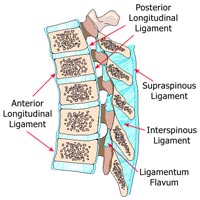The Spinal Ligaments
/ Martial Development and Formosa Neijia (this too) have recently posted about the tail bone. Here is my previous post on the subject.
Martial Development and Formosa Neijia (this too) have recently posted about the tail bone. Here is my previous post on the subject.Chris at Martial Development makes the point that martial artists often get stuck in the idea that their tail bone should be forward. He suggests that people focus on lifting the head and just relax the tail bone.
Unfortunately martial arts also get stuck in the idea of lifting the head which can lead to stiffness or over straightening. As we used to say in the dance world, "Straight is a look, not a feeling." (Think about that one.)
Speaking anatomically for a moment, there are four ligaments which go from the top of the spine to bottom, directly on the center-line. A ligament is a very strong flexible piece of tissue that connects bone to bone. It is not elastic! If a ligament stretches it is unlikely to stretch back. That's why all the muscles tighten up (or lock down if you prefer) around a
 ligament that is getting over worked.
ligament that is getting over worked.Each ligament in the spine can be felt. And each ligament can be felt simultaneously for even tension all the way up and down the spine.
So tucking, or straightening, or lifting up can all be wrong if they slacken or tighten one group of ligaments. The spine works as a whole unit, so it is usually a mistake to try to
 move just one part. Each vertebral-body (bone) can tilt forward or backwards somewhat like Venetian blinds.
move just one part. Each vertebral-body (bone) can tilt forward or backwards somewhat like Venetian blinds.But at a higher level if you are thinking inside the body about the details of anatomy you are making the mistake of "letting the spirit leave the body." The same goes for lifting up the head or sinking the tail bone. The mind or the "shen" goes out in all directions, if it goes up (like a rainbow fountain) without obstruction, the spine will follow--like a hungry tiger to its prey.
The notes for the cross section above are here:
Figure 10. A sagittal view of the human thoracic spinal cord, showing the (1) intervertebral discs, (2) vertebral bodies, (3) dura, (4) epidural space, (5) spinal cord, and (6) subdural space. A thick ligament, the anterior longitudinal ligament forms the anterior border of the spinal column. The posterior longitudinal ligament form the posterior border of the vertebral bodies.
